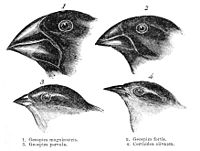
Photo from wikipedia
Measuring the selective fitness advantages provided by driver mutations has the potential to facilitate a precise quantitative understanding of cancer evolution. However, accurately measuring the selective advantage of driver mutations… Click to show full abstract
Measuring the selective fitness advantages provided by driver mutations has the potential to facilitate a precise quantitative understanding of cancer evolution. However, accurately measuring the selective advantage of driver mutations has remained a challenge in the field. Early studies reported small selective advantages of drivers, on the order of 1%, whereas newer studies report much larger selective advantages, as high as 1,200%. In this article, we argue that the calculated selective advantages of cancer drivers are dependent on the underlying mathematical model and stage of cancer evolution and that comparisons of numerical values of selective advantage without regard for the underlying model and stage can lead to spurious conclusions.
Journal Title: Cancer Research
Year Published: 2022
Link to full text (if available)
Share on Social Media: Sign Up to like & get
recommendations!